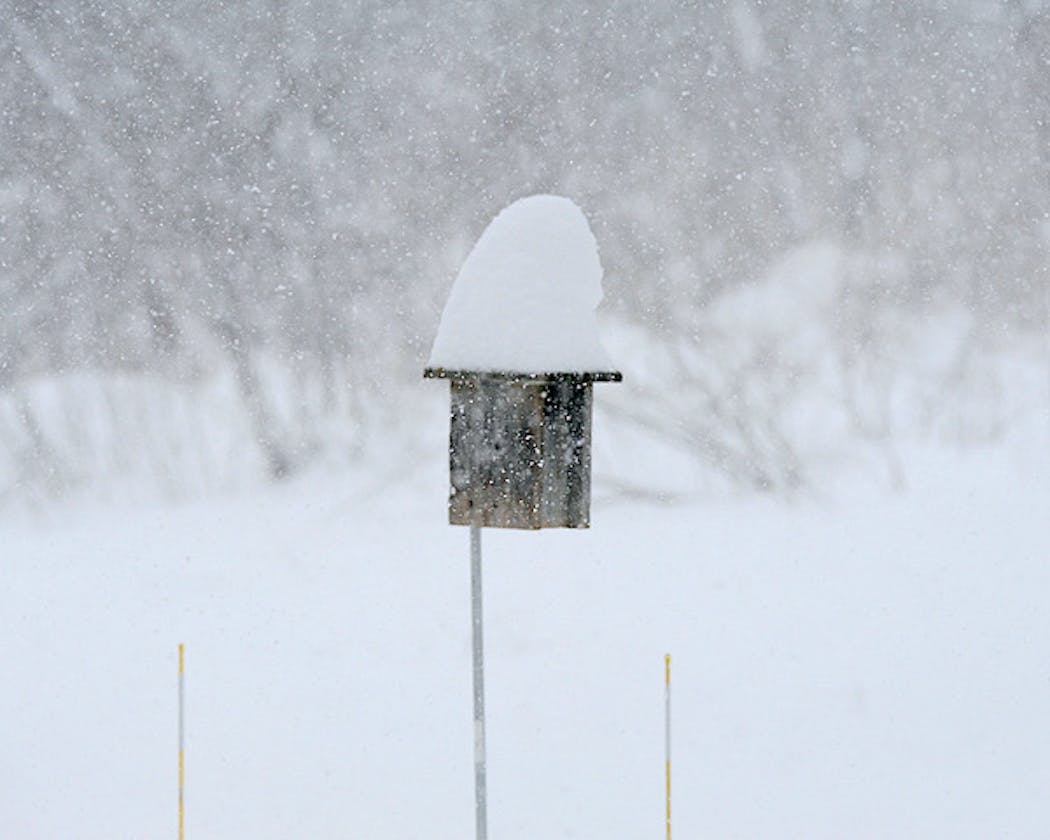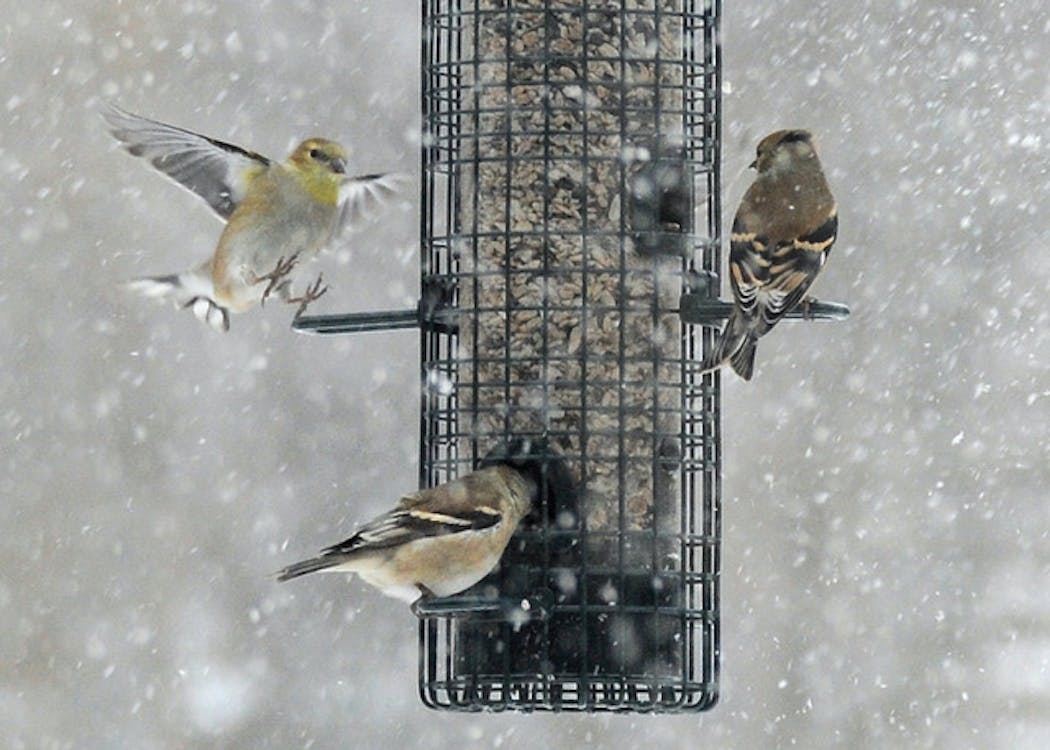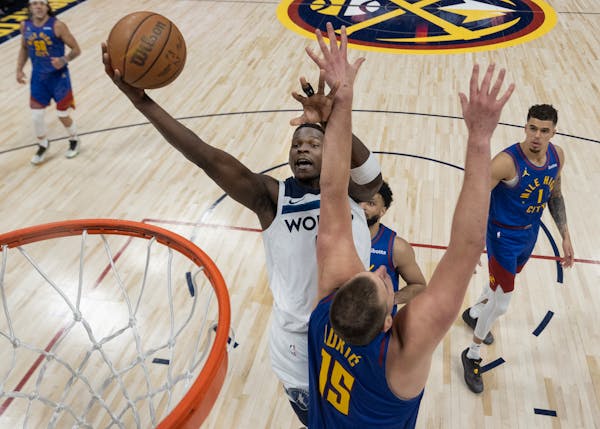Q: The blue jays just go crazy when I put out peanuts for them, they carry them off so fast there doesn't seem to be time for them to be eating them. What happens to all those nuts?
A: You're so right, blue jays are mad for peanuts and will return again and again to a feeder until every last one is gone. This happens in my backyard every morning at daybreak, minutes after I drop two handfuls of peanuts into a bird feeder: One blue torpedo after another shoots in and quickly snatches a nut. They fly off and cache most of them: They tap a few into the soil, or hide them under leaves, in cracks in stone walls, even rain gutters. The jays intend to come back later to eat the nuts, although squirrels beat them to it in many cases. Jays will eat a few peanuts right away, standing on a tree branch to peck open the shell.
That habit of hiding nuts for later is how many oak trees get planted, because jays are even more fond of acorns.
Night roosts
Q: I felt so helpless last winter as I watched birds trying to stay warm during very cold spells. Is there a shelter specifically designed for wintering birds, maybe even heated? Is this a bad idea?
A: It's not a bad idea at all, but keep in mind that the only birds that would use a night roosting box are birds that nest in tree holes or nest boxes. Winter birds that are primed to probe inside dark holes for places to nest or roost include, in our area, chickadees, bluebirds, titmice, nuthatches and small woodpeckers. I put up a night roost box some years ago, but from what I could tell, no birds ever used it. You can find several examples by doing an internet search for "winter roost boxes." I couldn't find any that were heated, probably because birds can generate their own heat on winter nights.
Most of our winter birds, including cardinals, goldfinches, juncos and blue jays, won't use such shelters and instead are looking for thick tangles of shrubs, or evergreen trees or brush piles to roost in at night. If you have the space, the best thing you can do for these birds is plant a spruce or pine tree or shrub, or create a brush pile out of tree branches and twigs.
Owl screeches
Q: I was hearing some screeching sounds every evening and early morning in early October. A bird identification app said it was a great horned owl but I'm wondering about a red-tailed hawk. What do you think?
A: I think you can rule out the hawk, since these raptors hunt in daylight and wouldn't be calling at night. But a great horned owl would very likely be making hoots and screeches as part of the courtship process. Male great horned owls begin setting up their territories in October, and start calling to a female owl. By the end of October, the male and female will have chosen a nest site (usually an old nest built by a red-tailed hawk, crow or squirrel) and the female begins laying eggs in January. To hear great horned owl calls, visit the Cornell Lab or Ornithology's All About Birds site, choose the owl and click on "sounds."
Toss moldy seed
Q: I've had a bag of sunflower seeds and there's some mold in there. Should I throw it out or can I continue feeding it to birds? I want to protect birds but those seeds have gotten very spendy, so am wondering.
A: to be on the safe side, you should toss that seed (into the trash, so birds can't still get at it). The part that birds eat is inside the shells, but they still could be sickened by mold or other toxins as they use their beaks or mouths to open the outer shell.
Finches stick around
Q: I'm thinking of taking my finch feeder down for the season and wonder when the goldfinches will fly south?
A: You certainly could take your finch feeder down in late autumn, but then you'll miss out on many entertaining hours of bird observation over the winter. Goldfinches don't migrate out of our region (although the birds you see in winter might not be the same birds that were here in the summer), so they're on the lookout for seeds year 'round. Your finch feeder is doubtless a popular feeding spot on their daily circuit. Don't be fooled by the lack of bright yellow birds at your finch feeder at the end of summer — the goldfinches are still out there, but they've molted into their winter coats, and these make them look as drab as sparrows.
Passive bird-watching
Q: I'd like to try bird-watching, but I have no experience in it, and am not sure where I would go and what I would do there. I'm not much of a hiker, to be honest, and am more interested in finding a nice perch for sitting to watch birds, near a lake or river. Is this a viable way to do it?
A: These are excellent questions, and you're certainly not alone — many people are interested in birds but aren't sure how to become a bird watcher. And you don't need to hike around to be a bird watcher, sitting in a good spot can be an excellent approach to seeing birds. If you have a friend who goes out to watch birds, I'd recommend tagging along for a short trek, having them point out what they're seeing, then you could settle in at one spot. Many of the local nature centers have trails, boardwalks and benches that are great for watching for birds, including Carpenter in Afton, Springbrook in Fridley, Wood Lake in Richfield, Westwood Hills in St. Louis Park, Silverwood Park in St. Anthony and many more. COVID has interrupted some programming but some of these centers offer bird hikes, open to everyone.
When I was just starting out, I did a very geeky thing, but it helped me become a better bird watcher: I bought a printed field guide, and paged through it often, looking at the bird images and the maps showing where they're found. This gave me a sense of what birds could be out there and what birds would be likely to be around my area: All you really need to do is to get outside and watch for birds, then look up any new ones in your field guide or phone app. Very soon, you'll have become a bona fide bird watcher.
Easy-to-clean feeder
Q: Can you recommend a bird feeder for goldfinches that's easy to clean?
A: I'm so glad you asked this question, because I feel that feeder hygiene is given too little attention. We invite birds into our landscapes by offering them food. This causes them to bunch up in groups at feeders, something they would not do in the wild. Crowding can lead to the spread of diseases, which can be fatal.
I almost never endorse specific products, but I've been looking for an easy-to-clean finch feeder for years, too, but couldn't find what I wanted. Some are complicated, requiring a lot of dexterity to reassemble after cleaning, and some can't be cleaned at all. Then I happened to stop in the Wild Birds Unlimited store in St. Paul recently. The staffer pointed out their house brand finch feeders, with snap-off bottoms for easy cleaning. I bought two of these and am very happy with them — they truly are easy to clean. After a rain- or snowstorm, it's a snap to click off the bottom, pour out wet seed and pour dry seed back in. As you know, goldfinches are very "poopy" birds, and these feeders are a breeze to wash and dry. I don't see any other products out there that perform as well as these.
Notes from readers
Sherri Larson wrote about my statement that I'd seen orioles at hummingbird feeders but not hummingbirds at oriole feeders: "For several years the hummingbirds have preferred the oriole feeders over their own in my backyard. I've tried different hummingbird feeders and different formulas [for the sugar water], but they still prefer the oriole food." [Wonder what's up with those stubborn hummingbirds? — VC]
And Naturalist Carrol Henderson writes that he's found a solution to the pesky yellowjackets and wasps that compete with hummingbirds for their sugar water in late summer and fall: "My strategy for dealing with them is to rub Avon Skin So Soft or Off! Skintastic onto the plastic flowers around the feeder ports. It repels the wasps but does not interfere with feeding by the hummingbirds." [Good tip for next summer — VC]
St. Paul resident Val Cunningham, a member of the St. Paul Audubon Society, writes about nature for local, regional and national newspapers and magazines, and can be reached at valwrites@comcast.net.





